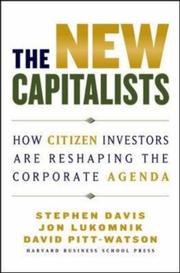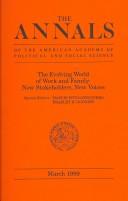| Listing 1 - 10 of 15 | << page >> |
Sort by
|
Book
ISBN: 1462375294 1452743231 1281605891 1451892217 9786613786586 Year: 2001 Publisher: Washington, D.C. : International Monetary Fund,
Abstract | Keywords | Export | Availability | Bookmark
 Loading...
Loading...Choose an application
- Reference Manager
- EndNote
- RefWorks (Direct export to RefWorks)
Fixed exchange rate regimes have come into disrepute, as their defense has become all but impossible. Yet, while a determined attack on a currency cannot be prevented or, ultimately, withstood, policies can reduce the vulnerability of a country to such attacks. The paper develops an analytical framework of costs and benefits of a fixed exchange rate, based on the ability of a developing country to meet its external obligations while achieving a maximum rate of long-term output growth. The focus is on how structural policies and institutions influence the degree of dependence of a country on a fixed exchange rate regime.
Exports and Imports --- Foreign Exchange --- Investments: General --- Industries: Financial Services --- Monetary Systems --- Standards --- Regimes --- Government and the Monetary System --- Payment Systems --- Economic History: Financial Markets and Institutions: General, International, or Comparative --- Economic History: Financial Markets and Institutions: Europe: Pre-1913 --- Economic Development: Financial Markets --- Saving and Capital Investment --- Corporate Finance and Governance --- International Investment --- Long-term Capital Movements --- Financial Institutions and Services: General --- Investment --- Capital --- Intangible Capital --- Capacity --- Currency --- Foreign exchange --- Finance --- Macroeconomics --- Exchange rates --- Conventional peg --- Foreign direct investment --- Financial sector --- Return on investment --- Balance of payments --- Economic sectors --- National accounts --- Investments, Foreign --- Financial services industry --- Saving and investment --- Brazil
Book
Year: 2014 Publisher: Washington, D.C., The World Bank,
Abstract | Keywords | Export | Availability | Bookmark
 Loading...
Loading...Choose an application
- Reference Manager
- EndNote
- RefWorks (Direct export to RefWorks)
"The Impact of Microcredit on the Poor in Bangladesh: Revisiting the Evidence," by David Roodman and Jonathan Morduch (2014) (henceforth RM) is the most recent of a sequence of papers and web postings that seeks to refute the findings of the Pitt and Khandker (1998; henceforth PK) article "The Impact of Group-Based Credit on Poor Households in Bangladesh: Does the Gender of Participants Matter?" that microcredit for women had significant, favorable effects on household consumption and other outcomes. In this version of RM, the authors have backed off many of their prior claims and methods after earlier replies noted their faults (see Pitt (1999), Pitt (2011a), Pitt (2011b), and Pitt and Khandker (2012)). Nonetheless, important claims against PK remain in this new version of RM and are addressed below. Readers should refer to Pitt and Khandker (2012) for a discussion of other issues with RM, including a discussion of the bimodal likelihood.
Bimodal Likelihood --- Econometrics --- Economic Theory & Research --- Finance and Financial Sector Development --- Financial Intermediation --- Household Consumption --- Least Square Likelihood --- Macroeconomics and Economic Growth --- Microcredit --- Science and Technology Development --- Scientific Research & Science Parks --- Statistical & Mathematical Sciences --- Web Postings
Book
ISSN: 02534517 ISBN: 1280014806 9786610014804 0585236445 Year: 1995 Volume: no. 119 Publisher: Washington, D.C. : World Bank,
Abstract | Keywords | Export | Availability | Bookmark
 Loading...
Loading...Choose an application
- Reference Manager
- EndNote
- RefWorks (Direct export to RefWorks)
Children --- Fertility, Human --- Mothers --- Mortality --- Statistical methods. --- Education --- Statistical methods
Book
ISBN: 9798400263699 Year: 2023 Publisher: Washington, D.C. : International Monetary Fund,
Abstract | Keywords | Export | Availability | Bookmark
 Loading...
Loading...Choose an application
- Reference Manager
- EndNote
- RefWorks (Direct export to RefWorks)
Labor force particiaption (LFP) in Romania is—at 66.8 percent in 2022—significantly lower than the EU average, especially among women and less educated people. With a declining working-age population, rasing LFP could yield signifcant benefits including by boosting long-term growth, mitigating the fiscal impact of an ageing society, and reducing inequality. Key policies to boost LFP include provision of affordabel high-quality childcare, and improving education standards.
Aging --- Demographic Economics: General --- Demographic Trends, Macroeconomic Effects, and Forecasts --- Demography --- Economics of Gender --- Economics of the Elderly --- Economics of the Handicapped --- Education --- Education: General --- Gender studies --- Gender --- Income economics --- International agencies --- International Agreements and Observance --- International Economics --- International institutions --- International organization --- International Organizations --- Labor Force and Employment, Size, and Structure --- Labor force participation --- Labor market --- Labor Standards: Labor Force Composition --- Labor --- Labour --- Monetary economics --- Monetary Policy --- Monetary policy --- Money and Monetary Policy --- Non-labor Discrimination --- Non-labor Market Discrimination --- Population & demography --- Population aging --- Population and demographics --- Population --- Women & girls --- Women --- Women's Studies --- Romania

ISBN: 1422101010 9781422101018 Year: 2006 Publisher: Boston, Mass. Harvard Business School Press
Abstract | Keywords | Export | Availability | Bookmark
 Loading...
Loading...Choose an application
- Reference Manager
- EndNote
- RefWorks (Direct export to RefWorks)
Money market. Capital market --- AA / International- internationaal --- 333.633 --- 347.728.3 --- 658.40 --- 650 --- 347.720.3 --- Aandelen. --- Aandelen. Rechten en vertegenwoordiging van de aandeelhouders. --- Financieel beheer van de bedrijven: algemeenheden. --- Theorieën en grondbeginselen. Management. --- Vennoten. Aandeelhouders. Toelating, terugtrekking en uitsluiting. Verantwoordelijkheden. --- Capitalism --- Investments. --- Social aspects. --- Investments --- Investing --- Investment management --- Portfolio --- Social aspects --- Aandelen --- Vennoten. Aandeelhouders. Toelating, terugtrekking en uitsluiting. Verantwoordelijkheden --- Aandelen. Rechten en vertegenwoordiging van de aandeelhouders --- Theorieën en grondbeginselen. Management --- Financieel beheer van de bedrijven: algemeenheden --- Finance --- Disinvestment --- Loans --- Saving and investment --- Speculation
Book
ISBN: 9780300223811 0300223811 9780300194418 0300194412 Year: 2016 Publisher: New Haven
Abstract | Keywords | Export | Availability | Bookmark
 Loading...
Loading...Choose an application
- Reference Manager
- EndNote
- RefWorks (Direct export to RefWorks)
A call to reboot capitalism and preserve
Financial institutions --- E-books --- Financial services industry --- Saving and investment --- United States. --- AB --- ABSh --- Ameerika Ühendriigid --- America (Republic) --- Amerika Birlăshmish Shtatlary --- Amerika Birlăşmi Ştatları --- Amerika Birlăşmiş Ştatları --- Amerika ka Kelenyalen Jamanaw --- Amerika Qūrama Shtattary --- Amerika Qŭshma Shtatlari --- Amerika Qushma Shtattary --- Amerika (Republic) --- Amerikai Egyesült Államok --- Amerikanʹ Veĭtʹsėndi͡avks Shtattn --- Amerikări Pĕrleshu̇llĕ Shtatsem --- Amerikas Forenede Stater --- Amerikayi Miatsʻyal Nahangner --- Ameriketako Estatu Batuak --- Amirika Carékat --- AQSh --- Ar. ha-B. --- Arhab --- Artsot ha-Berit --- Artzois Ha'bris --- Bí-kok --- Ē.P.A. --- EE.UU. --- Egyesült Államok --- ĒPA --- Estados Unidos --- Estados Unidos da América do Norte --- Estados Unidos de América --- Estaos Xuníos --- Estaos Xuníos d'América --- Estatos Unitos --- Estatos Unitos d'America --- Estats Units d'Amèrica --- Ètats-Unis d'Amèrica --- États-Unis d'Amérique --- Fareyniḳṭe Shṭaṭn --- Feriene Steaten --- Feriene Steaten fan Amearika --- Forente stater --- FS --- Hēnomenai Politeiai Amerikēs --- Hēnōmenes Politeies tēs Amerikēs --- Hiwsisayin Amerikayi Miatsʻeal Tērutʻiwnkʻ --- Istadus Unidus --- Jungtinės Amerikos valstybės --- Mei guo --- Mei-kuo --- Meiguo --- Mî-koet --- Miatsʻyal Nahangner --- Miguk --- Na Stàitean Aonaichte --- NSA --- S.U.A. --- SAD --- Saharat ʻAmērik --- SASht --- Severo-Amerikanskie Shtaty --- Severo-Amerikanskie Soedinennye Shtaty --- Si͡evero-Amerikanskīe Soedinennye Shtaty --- Sjedinjene Američke Države --- Soedinennye Shtaty Ameriki --- Soedinennye Shtaty Severnoĭ Ameriki --- Soedinennye Shtaty Si͡evernoĭ Ameriki --- Spojené obce severoamerick --- Spojené staty americk --- SShA --- Stadoù-Unanet Amerika --- Stáit Aontaithe Mheirice --- Stany Zjednoczone --- Stati Uniti --- Stati Uniti d'America --- Stâts Unîts --- Stâts Unîts di Americhe --- Steatyn Unnaneysit --- Steatyn Unnaneysit America --- SUA --- Sŭedineni amerikanski shtati --- Sŭedinenite shtati --- Tetã peteĩ reko Amérikagua --- U.S. --- U.S.A. --- United States of America --- Unol Daleithiau --- Unol Daleithiau America --- Unuiĝintaj Ŝtatoj de Ameriko --- US --- USA --- Usono --- Vaeinigte Staatn --- Vaeinigte Staatn vo Amerika --- Vereinigte Staaten --- Vereinigte Staaten von Amerika --- Verenigde State van Amerika --- Verenigde Staten --- VS --- VSA --- Wááshindoon Bikéyah Ałhidadiidzooígí --- Wilāyāt al-Muttaḥidah --- Wilāyāt al-Muttaḥidah al-Amirīkīyah --- Wilāyāt al-Muttaḥidah al-Amrīkīyah --- Yhdysvallat --- Yunaeted Stet --- Yunaeted Stet blong Amerika --- ZDA --- Združene države Amerike --- Zʹi͡ednani Derz͡havy Ameryky --- Zjadnośone staty Ameriki --- Zluchanyi͡a Shtaty Ameryki --- Zlucheni Derz͡havy --- ZSA --- ABŞ --- Amerikanʹ Veĭtʹsėndi͡avks Shtattnė --- É.-U. --- ÉU --- Saharat ʻAmērikā --- Spojené obce severoamerické --- Spojené staty americké --- Stáit Aontaithe Mheiriceá --- Wááshindoon Bikéyah Ałhidadiidzooígíí
Book
ISBN: 1608766144 Year: 2009 Publisher: New York : Nova Sciences Publishers,
Abstract | Keywords | Export | Availability | Bookmark
 Loading...
Loading...Choose an application
- Reference Manager
- EndNote
- RefWorks (Direct export to RefWorks)
Book
Year: 1932 Publisher: London Allen and Unwin
Abstract | Keywords | Export | Availability | Bookmark
 Loading...
Loading...Choose an application
- Reference Manager
- EndNote
- RefWorks (Direct export to RefWorks)

ISBN: 0761917306 Year: 1999 Publisher: Thousand Oaks Sage
Abstract | Keywords | Export | Availability | Bookmark
 Loading...
Loading...Choose an application
- Reference Manager
- EndNote
- RefWorks (Direct export to RefWorks)
Book
Year: 2012 Publisher: Washington, D.C., The World Bank,
Abstract | Keywords | Export | Availability | Bookmark
 Loading...
Loading...Choose an application
- Reference Manager
- EndNote
- RefWorks (Direct export to RefWorks)
"The Impact of Microcredit on the Poor in Bangladesh: Revisiting the Evidence," by David Roodman and Jonathan Morduch (2011) is the most recent of a sequence of papers and postings that seeks to refute the findings of the Pitt and Khandker (1998) article "The Impact of Group-Based Credit on Poor Households in Bangladesh: Does the Gender of Participants Matter?" that microcredit for women had significant, favorable effects on poverty reduction. In this paper the authors show that these latest Roodman and Morduch claims are based on seriously flawed econometric methods and theory and a lack of due diligence in formulating models and interpreting output from packaged software. On the basis of Roodman and Morduch's preferred two-stage least squares regression, an alternative calculation of the standard errors would lead one to conclude that the problem with Pitt and Khandker is that they underestimate the positive and statistically significant effect of women's credit on household consumption. As in their previous efforts, the methods of Roodman and Morduch are shown to bias the findings in the direction of rejecting the results of Pitt and Khandker. We also further examine two aspects of our instrumental variable approach that have been attacked by Roodman and Morduch. The first is the validity of the exclusion restrictions underlying the use of interactions between program choice and the set of exogenous variables (including the village fixed effects) as instruments. The second is the application of the "one-half acre" program eligibility rule. The authors show that identification does not require both of these, and present new results dropping each assumption in turn. The results originally reported in the Pitt and Khandker paper hold up extremely well in this new analysis.
Agriculture --- Econometrics --- Economic Theory & Research --- Household consumption --- Least squares regression --- Log-likelihood function --- Microcredit --- Poverty reduction --- Rural Development --- Science Education --- Scientific Research & Science Parks --- Statistical & Mathematical Sciences
| Listing 1 - 10 of 15 | << page >> |
Sort by
|

 Search
Search Feedback
Feedback About UniCat
About UniCat  Help
Help News
News